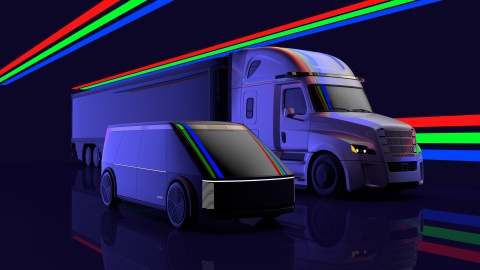
At its inaugural Studio Day in New York City, Luminar Technologies, Inc
(Nasdaq: LAZR) introduced Blade, its vision for the future of design and
integration of autonomous technology across robo-taxis, trucking and
consumer cars. Luminar also showcased the first consumer vehicle fully
integrated with Luminar’s Iris lidar, which is on-track for series
production with Luminar’s OEM partners, starting in late 2022. The company
is kicking off a global customer roadshow this week to demonstrate the
performance, capabilities, and design integration of Iris.
“Luminar is making the transition from the leader in lidar to the leader in
automotive autonomy and safety. Historically autonomous vehicle companies
have been exclusively focused on robo-taxis, but our focus has been building
the technology foundation for autonomy starting with consumer vehicles and
moving across verticals including trucks and robo-taxis,” said Austin
Russell, Founder and CEO of Luminar. “Ultimately, it takes more than just
great technology to deliver great design, and that’s exactly why we’re proud
to show off the Blade concept with Iris that goes beyond the cars of today
and visualizes the robo-taxis and trucks of tomorrow.”
Blade: The Autonomous Design Imperative
When it comes to automotive, harmony of form, function and technology is a
paramount ideal for consumers and car makers. Blade is a first-ever concept
and a powerful design expression of autonomous technology seamlessly
integrated into cars, trucks and robo-taxis. It creates a foundation for a
new vehicle architecture that automakers can incorporate into vehicle
development programs from the onset. The Blade concepts unveiled today for
robo-taxi and trucking represent a creative collaboration between Luminar
and NewDealDesign, led by acclaimed technology designer Gadi Amit.
“To create the best car design and user experience, autonomous technology
must be engineered and designed hand-in-hand from the ground up,” said Jason
Wojack, Senior Vice President of Product Development at Luminar who honed
his design-meets-engineering sensibility as the chief architect of the
Motorola Droid RAZR, which revolutionized the slimness of phones. “Focusing
on form and function at not just the lidar-level but the vehicle-level has
enabled Luminar to spearhead the design integration of autonomous
technology, which is among the fastest design breakthroughs in automotive
history.”
Luminar’s Iris is the first autonomous technology designed to marry form and
function: it combines performance, auto-grade robustness, scalability, and
automotive aesthetic seamlessly. Iris was designed from the beginning to be
cleanly integrated into the vehicle roofline, displacing the roof-rack style
conglomerates historically seen on autonomous development vehicles and
leapfrogging bolt-on products in development.
“Many technology companies under-appreciate the importance of design in
envisioning fundamental technology architecture, especially when it comes to
automotive. Luminar has redefined AV design with seamless consumer vehicle
integration, and is taking it to the next level with the Blade concept,”
said Amit. “We hope that Blade can become the manifestation of blending
lidar, autonomy, and next-generation vehicle design in an optimized and
iconic way.”
Luminar unveiled two Blade blueprints, which speak to the unique design and
use case requirements for robo-taxi and trucking. Both concepts integrate
the sensing technology into the roofline of the vehicle, creating an
autonomous “blade.”
Luminar’s Blade Robo-taxi design imagines:
A sleek, roomy and inspiring car design for autonomous operation on highways
and urban environments
Located for best performance, the golden ‘Blade’ runs across the crown of
the vehicle, incorporating 4 Luminar lidars for 360-degree coverage
Built for consumers as well as ridesharing operations as lines between
applications blur
Luminar’s Blade trucking design imagines:
A compact and seamless autonomous design integration
A three-lidar configuration for long-range sensing in all directions
Capability to retrofit onto existing class 8 trucks
Luminar remains focused on being the autonomous technology provider to the
automotive industry. The new Blade designs give Luminar partners a reference
for incorporating Luminar’s technology into their future vehicles and
demonstrates the company’s commitment to not only delivering leading-edge
technology but also beautiful design integration.
To view a replay of today’s webcast, please visit
www.luminartech.com/studioday; and follow the Iris roadshow on Twitter
@luminartech.
About Luminar Technologies:
Luminar is an autonomous vehicle sensor and software company with the vision
to make autonomy safe and ubiquitous by delivering the only lidar and
associated software that meets the industry’s stringent performance, safety,
and economic requirements. Luminar has rapidly gained over 50 industry
partners, including 8 of the top 10 global automotive OEMs. In 2020, Luminar
signed the industry’s first production deal for autonomous consumer vehicles
with Volvo Cars, while also recently striking deals with Daimler Truck AG
and Intel’s Mobileye. Luminar has also received minority investments from
the world’s largest commercial vehicle manufacturer, Daimler Truck AG, and
Volvo Cars, a global leader in automotive safety, to accelerate the
introduction of autonomous trucks and cars at highway speed. Founded in
2012, Luminar is a 400-person team with offices in Palo Alto, Orlando,
Colorado Springs, Detroit, and Munich. For more information please visit
www.luminartech.com.














More Stories
Shaping the future of the automotive industry at Automechanika Shanghai 2024 with the most fringe programme events and speakers yet
Some Ways How Motorists End Up in Collisions at U-Turns
Maximise Margins with Proven PPF Tactics